Paul Gilster's Blog, page 92
January 28, 2019
Artificial Intelligence and the Starship
The imperative of developing artificial intelligence (AI) could not be more clear when it comes to exploring space beyond the Solar System. Even today, when working with unmanned probes like New Horizons and the Voyagers that preceded it, we are dealing with long communication times, making probes that can adapt to situations without assistance from controllers a necessity. Increasing autonomy promises challenges of its own, but given the length of the journeys involved, earlier interstellar efforts will almost certainly be unmanned and rely on AI.
The field has been rife with speculation by science fiction writers as well as scientists thinking about future missions. When the British Interplanetary Society set about putting together the first serious design for an interstellar vehicle — Project Daedalus in the 1970s — self-repair and autonomous operation were a given. The mission would operate far from home, performing a flyby of Barnard’s Star and the presumed planets there with no intervention from Earth.
We’re at an interesting place here because each step we take in the direction of artificial intelligence leads toward the development of what Andreas Hein and Stephen Baxter call ‘artificial general intelligence’ (AGI), which they describe in an absorbing new paper called “Artificial Intelligence for Interstellar Travel,” now submitted to the Journal of the British Interplanetary Society. The authors define AGI as “[a]n artificial intelligence that is able to perform a broad range of cognitive tasks at similar levels or better than humans.”
This is hardly new terrain for Hein, a space systems engineer who is executive director of the Initiative for Interstellar Studies, or Baxter, an award-winning and highly prolific science fiction novelist. A fascinating Baxter story titled “Star Call” appears in the Starship Century volume (2013), wherein we hear the voice of just such an intelligence:
I am called Sannah III because I am the third of four copies who were created in the NuMind Laboratory at the NASA Ames research base. I was the one who was most keen to volunteer for this duty. One of my sisters will be kept at NASA Ames as backup and mirror, which means that if anything goes wrong with me the sentience engineers will study her to help me. The other sisters will be assigned to different tasks. I want you to know that I understand that I will not come home from this mission. I chose this path freely. I believe it is a worthy cause.
What happens to Sannah III and the poignancy of its journey as it reports home illuminates some of the issues we’ll face as we develop AGI and send it outward.

Image: A visualization of the British Interplanetary Society’s Daedalus Probe by the gifted Adrian Mann.
On the one hand, deep space mandates our work in AI, leading to this far more comprehensive, human-like intelligence, while at the same time human activities in nearby space face directly into the fact that space is a hostile place for biological creatures. There may develop evolutionary offshoots from Earth’s human stock as pioneering colonists move to Mars and perhaps the asteroids, tapping cyborg technologies and perhaps beginning a posthuman era.
I notice that in Martin Rees’ new book On the Future, the famed astrophysicist and Astronomer Royal speculates that pressures such as these may lead to the end of Darwinian evolution. Developing AGI would replace it with artificial enhancement of intelligence directed by increasingly capable generations of machines. It’s a conceivable outcome, and it’s one that would emerge more swiftly away from Earth, in Rees’ view. The need for powerful AGI for our explorations beyond the Kuiper Belt could well be a driving force in this development.
Of course, we don’t have to see future AI as excluding a human presence. One science fiction trope of considerable interest has been what Andreas Hein explored in earlier work (see Transcendence Going Interstellar: How the Singularity Might Revolutionize Interstellar Travel). One option for exploration: Send probes equipped with AGI to create the colonies that humans will eventually use. Could AGI raise a generation of humans from individual embryos upon arrival?
We can also think about self-replication. A first generation of probes could, as Frank Tipler and Robert Freitas have discussed, continually produce new generations, resulting in a step-by-step exploration of the galaxy.
Whether or not humans go with them or send them as humanity’s emissaries will depend on the decisions and technologies of the time. We have rich background speculations in science fiction to rely on, which the authors tap to analyze AI and AGI for a range of interstellar scenarios and the consequent mission architectures.
Thus AXIS (Automated eXplorer of Interstellar Space), the creation of Greg Bear in his novel Queen of Angels, which runs its own scientific investigations. Long-time Centauri Dreams readers will know of my interest in this novel because of the issues it raises about autonomy and growing self-awareness in AI far from human intervention. AXIS is an example of what Hein and Baxter refer to as ‘Philosopher’ probes. These are probes that, in contrast to probes with specific missions, are able to support open-ended exploration.
Probes like this are able, at least to some extent, to use local resources, which could involve manufacturing, hence the potential wave of new probes to further destinations. Agile and adaptive, they can cope with unexpected situations and produce and test hypotheses. A ‘Gödel machine’ contains a program that interacts with its environment and is capable of modification as it searches for proofs that such changes will produce benefits for the mission. Such a machine, write the authors, could “…modify any part of its code, including the proof searcher itself and the utility function which sums up the rewards…” and could “…modify its soft- and hardware with respect to a specific environment and even set its goals.”
‘Philosopher’ probes deserve more exploration, which I’ll get into tomorrow. But Hein and Baxter develop a taxonomy that includes four types, distinguished in terms of their objectives. We’ll need to look at samples of each as we consider AI and AGI as currently envisioned. The mix of formal and qualitative analysis available in this paper opens many a speculative door, pointing toward the paper’s design of a generic AI probe and predictions about AI availability.
The paper is Hein & Baxter, “Artificial Intelligence for Interstellar Travel,” submitted to JBIS (preprint).






January 23, 2019
What’s Next for New Horizons?
The exuberance of images like the one below captures the drama of Solar System exploration. Scenes like this are emblematic of the early reconnaissance of the Solar System. We saw similar enthusiasm with missions near and far — I’m thinking back, for example, not just to Voyager, but the Viking landings on Mars, and I’m sure Russian controllers were equally jubilant when their Venera craft touched down on Venus. Space is indeed the ‘final frontier,’ as James T. Kirk reminded us on Star Trek, and it’s a frontier that goes on without end.
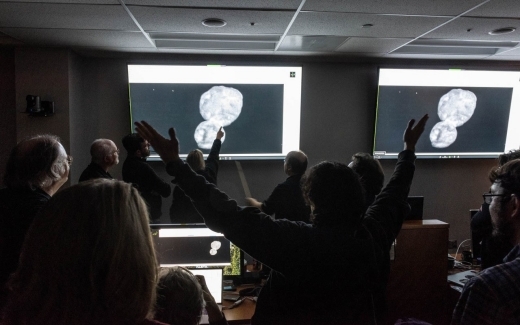
Image: Celebration in full swing as mission controllers react to the view from New Horizons after the Ultima Thule flyby. Credit: Henry Throop and Ed Whitman.
Let’s keep in mind, then, that New Horizons is not just returning Ultima Thule data, but continuing to push into the Kuiper Belt doing good science. In terms of future missions, we need to learn as much as we can about radiation, gas and dust as we assess the environment. New Horizons will get an extended mission, we can hope with some justification, because after all, a fully operational spacecraft operating in this far region is a unique, invaluable resource.
But we don’t have to wait for an extension to continue exploring Kuiper Belt objects, even if no flyby is possible. I’m thinking of one called 2014 PN70, which will be observed in March. As mission principal investigator Alan Sterne notes in this latest report, this KBO was a proposed flyby target before Ultima Thule was chosen, losing out at least partly because it required more fuel to reach than Ultima.
Although the spacecraft won’t be able to see it up close, we should still be able to assess 2014 PN70’s shape, surface properties and rotation rate, as well as look for possible satellites. Discovered in Hubble observations, the object is known to be about 40 kilometers in diameter. New Horizons will be unable to resolve 2014 PN70 or another early flyby candidate, 2014 OS393, but study of both will help put the accumulating Ultima Thule data in perspective.
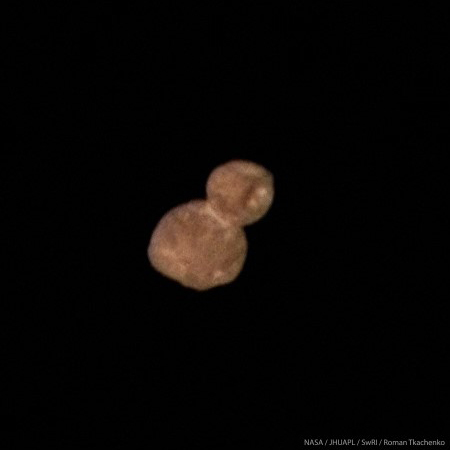
Image: Ultima Thule as seen in color by New Horizons during its close approach. Credit: NASA/JHUAPL/SwRI/Roman Tkachenko.
Recovering the entirety of New Horizons data on Ultima Thule will take 20 months, and recall that from January 4 to 9, controllers had to wait because the spacecraft was obscured by the solar corona, making communications problematic. At this point, the team has just 1 percent of all the Ultima Thule data. Hundreds of images and spectra remain to be downloaded, but the process of compiling science results is already well underway, with 40 abstracts submitted to the 50th Lunar and Planetary Science Conference, to be held in Houston this March.
What a primitive place Ultima turns out to be, a fact which comes as no surprise. In the abstract for his talk in Houston, Stern summarizes its nature this way:
New Horizons has revealed MU69 to be a bi-lobate contact binary that appears to have merged at low speed. In addition to being the most primitive solar system object ever to be explored in situ by any spacecraft, MU69 thus also becomes the first primordial contact binary. The appearance and contact binary nature of this object is consistent with it being a relic planetesimal possibly created by pebble accretion. How MU69’s two lobes merged, how gently, and how much angular momentum was lost prior to contact are puzzles to be solved as more data are returned and detailed modeling can be undertaken.
Ultima Thule, then, as well as other Kuiper Belt objects we’ll study with New Horizons and later missions, becomes a key to the formation era of the Solar System, offering potential insights into planetary accretion. The available data have revealed no evidence of rings, a moon or an atmosphere, though we have to hold on that point until the dataset is complete. Differences in surface reflectivity are clear, including the striking brightness of the connecting ‘neck’ between the two lobes (the larger of which is now nicknamed Ultima, the smaller Thule).
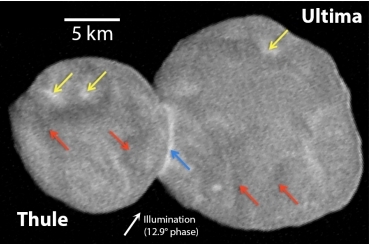
Image: This is Figure 1 from Stern’s abstract. Caption: Ultima Thule as seen by the LORRI imager in the close approach CA04 observation (140 m/pixel), including relatively bright circular patches a few km wide (yellow arrows), darker regions up to several km wide (red arrows), a bright, cylindrically symmetric neck (blue arrow), and quasi-linear and arcuate bright features; note also the mottled appearance. Credit: JHU/APL; Alan Stern.
On the matter of dust, this is interesting:
Regarding dust near Ultima Thule, New Horizons saw no evidence down to I/F~5×10-7 in imaging available by 4 Jan 2019. In addition, zero impacts onto the New Horizons dust counter were detected inside MU69’s Hill sphere. And no satellites were detected down to 1.5 km diameter (under the assumption of an Ultima Thule-like reflectivity) outside of 1000 km from Ultima Thule. A search for closer rings or satellites has not yet been performed.
If New Horizons gets that extended mission, it should begin in late 2021. The good news that Stern passes along in his PI’s Perspective is that the spacecraft was able to conserve some of the fuel that had been allocated for the Ultima Thule flyby. Fully operational and with a potent science package, New Horizons is good to go for further Kuiper Belt exploration.






January 21, 2019
‘Oumuamua, SETI and the Media
One of the more important things about the interstellar object called ‘Oumuamua is the nature of the debate it has engendered. Harvard astronomer Avi Loeb’s paper examining it as a possible technology has provoked comment throughout the scientific community, as witness Jason Wright’s essay below. Dr. Wright (Penn State) heads the Glimpsing Heat from Alien Techologies (G-HAT) project, which he described in these pages, and is a key player in the rapidly developing field of Dysonian SETI, the study of possible artifacts as opposed to deliberate communications from extraterrestrial civilizations. Here he looks at the debate Loeb’s work has engendered and its implications not only for how we do science but how we teach its values to those just coming into the field. Jason’s essay was originally posted several days ago on his Astrowright blog, which should be a regular stop for Centauri Dreams readers.
by Jason T. Wright

Avi Loeb is the chair of the astronomy department at Harvard, a distinguished and well cited astronomer (he has an h-index of 87), and the chair of the Breakthrough Starshot initiative. He’s a strong proponent of making sure that science doesn’t succumb to groupthink and champion of outré ideas.
He also has been making headlines recently for articles he has co-authored, interviews he has given, and popular media columns he has written about the possibility that fast radio bursts, and now ‘Oumuamua, are artificial in origin. This has created a great deal of buzz in popular culture and a lot of hand-wringing and criticism on social media by scientists who find his actions irresponsible. Many have asked my opinion, so I’m collecting my many thoughts on the topic in this post.
I am happy to defend Avi on these grounds:

He is driving us to have an important conversation about what “acceptable” SETI research looks like, and in this conversation I’m mostly on his side. He’s essentially moving the scientific equivalent of the “Overton Window” towards SETI, and that’s a good thing. These are exciting and interesting questions and we should not let the face-on-Mars/Ancient-Aliens/UFOlogy types prevent us from discussing them.
He is using tenure and his stature the way we all imagine it’s supposed to be used: as a shield so that he can explore potentially unpopular research avenues without fear of retribution or ostracism. We all imagine that’s what we would do in his position (I hope!) but too often it ends up just being a club to get junior scientists to conform to one’s vision for what “proper” science looks like and what “good” problems are.
The papers he and his postdocs are writing are important first steps in making Solar System and other forms of SETI a serious academic discipline.
He is being a role model for how scientists can explore outré ideas and spend an appropriate amount of their time on potential breakthroughs.
He is putting SETI in the public eye and doing a lot of outreach.
Image: Harvard’s Avi Loeb, at the center of the discussion of ‘Oumuamua. Credit: Harvard University.
Avi wouldn’t be pushing the envelope hard enough if he weren’t getting some pushback, and indeed there is plenty of fair and good-faith criticism that can be made about his approach (not all of which I agree with):
The degree of certainty he expresses in ‘Oumuamua being artificial does seem unwarranted to me (though to be fair I’ve always been an ‘Oumuamua-might-be-artificial skeptic.)
Given the way we know the press (especially the yellow press) will handle any story about “aliens”, one can argue that the “extraordinary claims require extraordinary evidence” maxim is especially applicable to SETI (I’ve made this argument strongly when discussing my own research in the press.) Avi could hew more closely to this maxim.
The tone of his papers and his public comments are quite divergent. The body of the paper on ‘Oumuamua-as-lightsail, for instance, has a brief mention about the potential of the artifice of ‘Oumuamua at the end, but most of it is about the perfectly general problem of thin objects in interstellar space. Snopes highlights this divergence well pointing out that the paper is quite sober and restrained compared to some of the media coverage. (It’s true that the title and abstract of the paper are about ‘Oumuamua specifically, and that it serves as the case study for the whole analysis.) Avi’s public statements are much less conservative and equivocal.
He is not just quietly following the evidence; he is using his platform to have a very public and high-visibility discussion about his research. I will concede that Avi is an exception to my earlier (somewhat petulant) protest that SETI scientists are not in it for the attention. That said, I will object to anyone who would claim Avi is only in it for the attention, or that such attention is inherently a bad thing.
Many of his papers are de novo explorations of topics like the fate of comets in interstellar space, with little connection to the substantial amounts of work that has already been done on the topic, and his papers would be better and less naive if they had a closer connection to this prior work rather than starting from scratch.
Uh… I'll just say there's some relevant literature for the erosion of comets by the ISM. Also, the literature for lightcurves is pretty extensive. The paper does not attempt to show that a tumbling flat sheet is a non-rejectable fit to the available lightcurve data.
— Michele Bannister (@astrokiwi) December 26, 2018
More broadly, let’s look at two threads on Twitter criticizing Avi. I’ll start with this one by Bryan Gaensler:
New theories need to make predictions. If reality doesn’t match predictions, your theory is wrong.
The problem with aliens as a theory is that if your predictions fail, you can just give your aliens additional new powers and adjust your theory.
— Bryan Gaensler
January 18, 2019
A Disk at an Angle (and a Remarkable View)
One of the joys of science fiction is imagining landscapes. What would it be like to stand on Titan, for example, a question that was inescapably influenced in my youth by Chesley Bonestell’s wonderful depictions, as well as novels like Larry Niven’s World of Ptavvs (1966) or Michael Swanwick’s novelette “Slow Life” (Analog, December 2002). And then, of course, there were those multi-star skies, as in Asimov’s “Nightfall” (Astounding Science Fiction September, 1941.
The Science Fiction Writers of America, incidentally, voted “Nightfall” the best science fiction story written prior to 1965, when the Nebula Awards began. I would bet almost all Centauri Dreams readers are familiar with it, but if not, it’s widely anthologized.
And now we have another visual phenomenon to contend with, a landscape and its sky that had never occurred to me. A team led by Grant Kennedy (University of Warwick, UK) has discovered the first confirmed case of a multiple star system whose surrounding disk of gas and dust circles the central stars at right angles. The work grows out of data gathered with the Atacama Large Millimeter/sub-millimeter Array (ALMA). Says Kennedy:
“Discs rich in gas and dust are seen around nearly all young stars, and we know that at least a third of the ones orbiting single stars form planets. Some of these planets end up being misaligned with the spin of the star, so we’ve been wondering whether a similar thing might be possible for circumbinary planets. A quirk of the dynamics means that a so-called polar misalignment should be possible, but until now we had no evidence of misaligned discs in which these planets might form.”
So let’s imagine a planet forming in the dust ring, just as we know planets form in the disks we’ve found around single stars. From the surface of such a world, our new science fictional setting shows us the disk as a band rising out of the horizon, with the twin stars moving in and out of the disk plane, so that we get two shadows much of the time. Our circumbinary planet in its all but perpendicular orbit of the primaries might see a scene like the one below.

Image: View from an orbiting planet. Copyright: University of Warwick/Mark Garlick. Used with permission.
The young system in question is found at HD 98800, also known as TV Crateris, in the constellation Crater, somewhere around 150 light years away from the Sun. This is actually a quadruple star system found in the TW Hydrae association. HD 98800 A is a K-class dwarf probably orbited by a red dwarf, while HD 98800 B is likewise a K-class, red dwarf pairing. A planet in this system — and bear in mind that this is a very young system, so the planet-forming process would be early — would have four nearby stars to color its landscape.
The authors do not believe such systems are rare. From the paper:
If planet formation can proceed equally efficiently in both coplanar and polar configurations, circumbinary planets on polar orbits are predicted to be nearly as common as their coplanar brethren (although these fractions may be modified by later dynamical evolution). The most eccentric binaries are the most likely to have polar disk configurations, so it is not surprising that the known transiting circumbinary planets, which are near to coplanar, are all in systems with e≤0.52, with 8 out of 9 having e
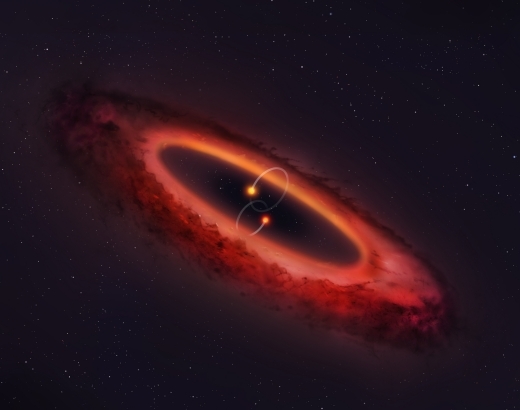
Image: View of the double star system and surrounding disc. Copyright: University of Warwick/Mark Garlick. Used with permission.
Is there, then, a large population of such unusually aligned circumbinary planets awaiting discovery? If so, we’ll have a variety of further interesting landscapes to consider, even as we ponder the kind of seasonal variations that can occur on circumbinary worlds circling a wide range of stellar classes and their own possible companions. Plenty of material here for writers, or has some far-sighted SF wordsmith already depicted such a planet? If so, please let me know in the comments.
The paper is Kennedy et al., “A Circumbinary Protoplanetary Disc in a Polar Configuration,” Nature Astronomy 14 January 2019 (abstract).






January 17, 2019
A Closer Look at Barnard’s Star b
Barnard’s Star b, the planet announced last November around the second nearest star system to the Earth, has been the subject of intensive study by an international team led by Ignasi Ribas at the Institute of Space Studies of Catalonia (IEEC), and Institute of Space Sciences (ICE, CSIC). As announced at the recent meeting of the American Astronomical Society in Seattle, the work helps to refine the age of Barnard’s Star and examines its potential for supporting life on its known planet.
We don’t know whether there are other planets around Barnard’s Star, but the fact of Barnard Star b’s existence is significant, according to Scott Engle (Villanova University), who along with colleague Edward Guinan presented the results in Seattle. Says Engle:
“The most significant aspect of the discovery of Barnard’s Star b is that the two nearest star systems to the Sun are now known to host planets. This supports previous studies based on Kepler Mission data, inferring that planets can be very common throughout the galaxy, even numbering in the tens of billions.”
Indeed, the idea of at least one planet around every star gains currency, and in terms of our own position in the cosmos, it bears noting that many stars in our stellar neighborhood are far older than our own. On that point, the new work benefits from the running analysis performed by a Villanova program called Living with a Red Dwarf, which homes in on the radiative environments that planets around such stars would be subject to as their host evolves. The goal is to make a determination of the likelihood that complex molecules can form, and whether life can evolve.
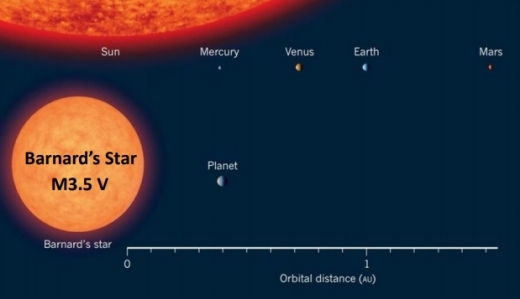
Image: Model of the Barnard’s Star planet system (from Ribas et al. 2018) compared to the inner Solar System. Barnard b orbits at 0..404 AU from its M3.5V host star and has an equilibrium temperature of T=-168C° in its 233-day orbit. Credit: Edward Guinan, Scott Engle / Villanova University.
The gathering of photometric data on Barnard’s Star under this project goes back to 2003, determining a rotation period of 142±8 days, a value that agrees well with other recent studies. The team then used the rotation period to extract a likely age of 8.6 billion years. Estimating stellar age for low-mass stars through rotation is a field known as gyrochronology, one that has accumulated a significant history of published analysis in the past decade. The age determined here also fits other age indicators to establish a result with 1.2 billion years play on either side.
As to that interesting planet, Barnard’s Star b is a super-Earth orbiting far enough from the primary to be cold (-168 C°), with only about 2 percent of light relative to the Earth. What the researchers go on to point out in their presentation is that as a super-Earth with a minimum mass of 3.25 Earth masses, Barnard’s Star b could have a hot iron/nickel core with resulting geothermal activity. The potential, if water is present, is for liquid water under an icy surface.
Geothermal heating could support “life zones” under its surface, akin to subsurface lakes found in Antarctica,” Guinan said. “We note that the surface temperature on Jupiter’s icy moon Europa is similar to Barnard b but, because of tidal heating, Europa probably has liquid oceans under its icy surface.”
We can only speculate about such matters, and the range of outcomes depending on the mass of the planet is wide. Note the range of possibilities in the authors’ presentation, called “X-Ray, UV, Optical Irradiances and Age of Barnard’s Star’s New Super Earth Planet – ‘Can Life Find a Way’ on such a Cold Planet?”:
Although little is definitely known about geomagnetism of superearths like Barnard b, a large liquid iron core, that could strong generate geomagnetic fields, could offer protection from strong winds and coronal mass ejections when the star was young & magnetically active. However, if the mass of the Barnard b is much higher than about 7–10 M⊕, its higher gravity could result in it retaining a thick H2 -He atmosphere and thus be a dwarf gas giant (mini-Neptune). In this case all hope for life is probably lost unless by chance Barnard b hosts an icy moon (with a subsurface ocean) that could be tidally heated like Europa.
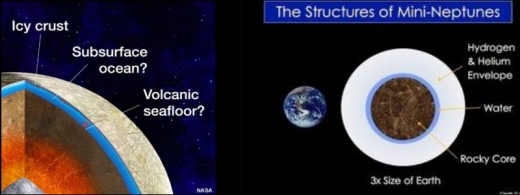
Image: (L) Possible model of Barnard b based on geothermal heating. If water is present, geothermal heating could create a subsurface ocean where primitive life could exist. The model would be a scaled-up Europa. (R) In another scenario if the mass of the exoplanet is > 7 M⊕, then the stronger gravity could cause the retention of its primordial H2/He atmosphere. These planets are known as Mini-Neptunes / Dwarf Gas Giants. Credit: Edward Guinan, Scott Engle / Villanova University.
To learn more, we need to image the planet, an observation that would tell us about its atmosphere, surface and potential for life. On this score, the news is promising. Barnard’s Star b has an angular separation from its host that is much larger than Proxima b from Proxima Centauri, and may well be imaged by the next generation of extremely large telescopes (ELTs). It may also prove a target for the James Webb Space Telescope or the WFIRST mission.
For more, see Toledo-Padrón, “Stellar activity analysis of Barnard’s Star: Very slow rotation and evidence for long-term activity cycle” (preprint), which includes the high-precision photometry data of Barnard’s Star used in this analysis.






January 16, 2019
Red Dwarf Planets May Lack Needed Volatiles
We can identify a number of circumstellar disks, but most are too far away to provide internal detail, much less the kind of activity that seems to be showing up around the red dwarf AU Microscopii. For at 32 light years out in the southern constellation Microscopium, AU Microscopii is presenting us with an unusual kind of activity that may have repercussions for the question of life around red dwarf stars in general. As presented at the recent meeting of the American Astronomical Society, fast-moving blobs of material are eroding the disk.
The consequence: Icy materials and organics that might have developed in asteroids and comets may instead be pushed out of the disk, long before they could provide the infall of materials thought to have benefited planets like ours. “The Earth, we know, formed ‘dry,’ with a hot, molten surface, and accreted atmospheric water and other volatiles for hundreds of millions of years, being enriched by icy material from comets and asteroids transported from the outer solar system,” said co-investigator Glenn Schneider (Steward Observatory, Tucson, Arizona).
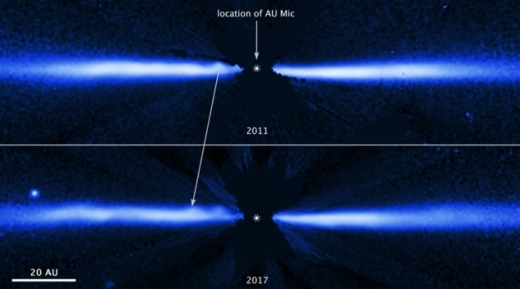
Image: These two NASA Hubble Space Telescope images, taken six years apart, show fast-moving blobs of material sweeping outwardly through a debris disk around the young, nearby red dwarf star AU Microscopii (AU Mic). The top image was taken in 2011; the bottom in 2017. Hubble’s Space Telescope Imaging Spectrograph (STIS) took the images in visible light. This comparison of the two images shows the six-year movement of one of the known blobs (marked by an arrow). Credit: NASA, ESA, J. Wisniewski (University of Oklahoma), C. Grady (Eureka Scientific), and G. Schneider (Steward Observatory).
Researchers estimate that the blob of material in the image above is moving at about 24,000 kilometers per hour. It would have moved more than 1.3 billion kilometers between 2011 and 2017, roughly the distance between the Earth and Saturn when the two are at their closest approach to one another. Continually pushing small particles containing water and other volatiles out of the system, such circumstellar materials could cause the AU Microscopii disk to dissipate in 1.5 million years. Each blob — and thus far the team has found six of them — is thought to mass four ten-millionths the mass of Earth.
The ejection speeds among the six identified blobs range between 14,500 kilometers per hour and 43,500 kilometers per hour, well beyond escape velocity for the star. Their current distance ranges from 1.5 billion kilometers from the star to more than 8.8 billion kilometers. AU Microscopii’s relative proximity makes it possible for Hubble to resolve substructure in at least one of the blobs, which may eventually make it possible to discover their origins.
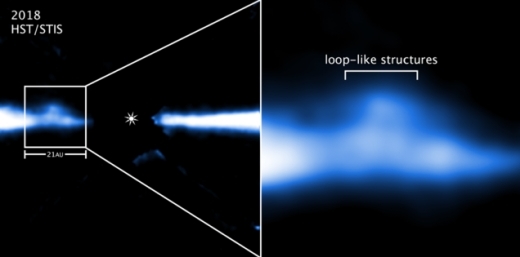
Image: The box in the image at left highlights one blob of material extending above and below the disk. Hubble’s Space Telescope Imaging Spectrograph (STIS) took the picture in 2018, in visible light. The glare of the star, located at the center of the disk, has been blocked out by the STIS coronagraph so that astronomers can see more structure in the disk. The STIS close-up image at right reveals, for the first time, details in the blobby material, including a loop-like structure and a mushroom-shaped cap. Astronomers expect the train of blobs to clear out the disk within only 1.5 million years. The consequences are that any rocky planets could be left bone-dry and lifeless, because comets and asteroids will no longer be available to glaze the planets with water or organic compounds. Credit: NASA, ESA, J. Wisniewski (University of Oklahoma), C. Grady (Eureka Scientific), and G. Schneider (Steward Observatory).
We wind up with planets lacking the nearby volatiles to enrich them, giving us the prospect of dry, dusty worlds without life. We can add this to the other factors that challenge the emergence of life around red dwarf stars, such as possible tidal lock and the resulting climate issues, not to mention heavy ultraviolet flux from young stars that could strip away the atmosphere of planets in the habitable zone. AU Microscopii is itself 23 million years old, an infant in stellar terms. Bear in mind that red dwarfs are the most common type of stars in the galaxy.
“The fast dissipation of the disk is not something I would have expected,” says Carol Grady (Eureka Scientific, Oakland, California), a co-investigator on the Hubble observations. “Based on the observations of disks around more luminous stars, we had expected disks around fainter red dwarf stars to have a longer time span. In this system, the disk will be gone before the star is 25 million years old.”
The AU Microscopii data were gathered by the European Southern Observatory’s Very Large Telescope in Chile as well as the Hubble Space Telescope Imaging Spectrograph (STIS) by a team led by John Wisniewski (University of Oklahoma). The STIS visible light images, taken in 2010-2011, were followed up by near-infrared work at the the SPHERE (Spectro-Polarimetric High-contrast Exoplanet Research) mounted on the VLT. The work also draws on disk observations of AU Microscopii by the Hubble Advanced Camera for Surveys in 2004.






January 15, 2019
‘Oumuamua: Future Study of Interstellar Objects
‘Oumuamua continues to inspire questions and provoke media attention, not only because of its unusual characteristics, but because of the discussion that has emerged on whether it may be a derelict (or active) technology. Harvard’s Avi Loeb examined the interstellar object in these terms in a paper with Shmuel Bialy, one we talked about at length in these pages (see ‘Oumuamua, Thin Films and Lightsails). The paper would quickly go viral.
Those who have been following his work on ‘Oumuamua will want to know about two articles in the popular press in which Loeb answers questions. From the Israeli newspaper Ha’aretz comes an interview conducted by Oded Carmeli, while at Der Spiegel Johann Grolle asks the questions. From the latter, a snippet, in which Grolle asks Loeb what the moment would be like if and when humanity discovers an extraterrestrial intelligence. Loeb’s answer raises intriguing questions:
I can’t tell you what this moment will look like. But it will be shocking. Because we are biased by our own experiences. We imagine other beings to be similar to us. But maybe they are radically different. For example, it is quite possible that we won’t encounter the life forms themselves, but rather only their artifacts. In any case, we ourselves are not designed for interstellar journeys. The only reason astronauts survive in space is that they are under the protection of the Earth’s magnetic field. Even when traveling to Mars, cosmic rays will become a major problem.

Image: Avi Loeb (center) at the Daniel K. Inoue Solar Telescope (DKIST) in June of 2017. Credit: Avi Loeb.
Intriguing, given our conversations here about artificial intelligence and the emergence of non-biological civilizations. After all, we are in the nearby galactic company of numerous stars far older than our own. Would robotic beings supplant their biological cousins, or would the scenario be more like biological beings using artilects as their way of achieving interstellar travel? Either way, Loeb’s guess is that our first evidence will be an encounter with technological debris. The interview goes on to cover the ‘Oumuamua story’s outline thus far.
Meanwhile, two new papers from Loeb have appeared, the first written with John C. Forbes. “Turning Up the Heat on ‘Oumuamua” looks at the interstellar object, whatever it is, from another angle. If we were to discover more objects like this, how could we best analyze them? In earlier work with Manasvi Lingam, Loeb examined the population of interstellar objects that could be trapped within the Solar System, slung by Jupiter into parabolic orbits around the Sun.
The number could be as high as 6,000, a figure based on the deduced abundance of interstellar objects given the fact that we observed ‘Oumuamua as early as we did with instrumentation of the sensitivity of the Pan-STARRS telescopes. The paper references work on the overall abundance of these objects performed in 2017 by Greg Laughlin (UC-Santa Cruz) and Konstantin Batygin (Caltech), as well as a 2018 paper from Aaron Do (University of Hawai’i).
Learning more could involve a flyby mission, says Loeb, but there may be a better way:
In our new paper with John Forbes we proposed instead studying the vapor produced when such objects pass close to the Sun and get evaporated by the intense solar heat. We calculated the likelihood of that happening, keeping in mind that `Oumuamua did not show any signs of a cometary tail or carbon-based gas since it did not pass close enough to the Sun.
We used the known orbit of `Oumumua and assume a population of similar interstellar objects on random orbits in the vicinity of the Sun. This provided us with a likelihood of passages close to the Sun.
These objects would be expected to show a high orbital inclination, and assuming a population of this size, they should be readily detectable by future telescopes, such as the forthcoming Daniel K. Inoue Solar Telescope (DKIST). Another marker of interstellar origin, according to the paper, would be anomalous oxygen isotope ratios. If we can find interstellar objects that pass close to the Sun, we should be able to learn something about their composition. Loeb and Forbes use Monte Carlo methods to determine that such objects collide with the Sun once every 30 years, while about two should pass within the orbit of Mercury each year.
Usefully, spectroscopic study of cometary tails is a well-practiced science. As the paper notes:
Generally these studies are able to classify comets into different groups depending on the inferred production rates of H2O, C2, CN, and NH2 as well as dynamical properties, which likely reflect formation in different parts of the protoplanetary disk (Levison 1996)… The promise of using close encounters with the sun to learn about extrasolar small bodies is that the sun has the ability to disrupt even large cometary nuclei via its intense radiation, sublimating not just surface volatiles but even silicates and iron. In principle this exposes the interiors of these objects to remote spectroscopy, which could place strong constraints on the composition of these objects.
And indeed, two comets — 96P/Machholz 1 and Yanaka (1998r) — have been found to have depleted levels of CN and C2 relative to water. Sun-grazing comets of interstellar origin, assuming we can identify them early through instrumentation like the LSST (Large Synoptic Survey Telescope) should be available for such examination, a way to probe their composition without the need for sending fast flyby missions, although the latter would obviously be useful.
In a second paper, just accepted at Research Notes of the American Astronomical Society. Loeb and Harvard colleague Amir Siraj note that ‘Oumuamua’s shape may be more extreme than we have thought. Noting that the axis ratio for the object has been pegged at between 6:1 and 10:1, the paper delves into the lightcurve, with a startling result, as Loeb explained in an email this morning:
The lightcurve of the interstellar object Oumuamua showed a net brightening by one magnitude between October and November 2017, after corrections for the changing distances to the Sun and Earth and solar phase angle, assuming isotropic uniform albedo and the canonical phase function slope value for cometary and D-class objects of -0.04 magnitude per degree. We used the change in the orientation of `Oumuamua between October and November 2017 to show that this brightening implies a more extreme shape for the object. We inferred a ratio between its brightest and dimmest phases of at least 50:1 for a cigar shape and 20:1 for a pancake-like geometry. The revised values can be avoided if the phase function slope is 3 times larger than the canonical value, implying in turn another unusual property of `Oumuamua.
Variations in albedo could be in play, although here we would be looking at sharp variations for a minor change in viewing angle of ~ 11°, which Loeb and Forbes consider a possibility, though one without precedent in previous studies of asteroids and comets.
The papers are Forbes and Loeb, “Turning Up the Heat on ‘Oumuamua,” submitted to The Astrophysical Journal Letters (preprint); and Siraj and Loeb, “‘Oumuamua’s Geometry Could be More Extreme than Previously Inferred,” accepted at Research Notes of the American Astronomical Society (full text).






January 11, 2019
Is Most Life in the Universe Lithophilic?
Seeking life on other worlds necessarily makes us examine our assumptions about the detectability of living things in extreme environments. We’re learning that our own planet supports life in regions we once would have ruled out for survival, and as we examine such extremophiles, it makes sense to wonder how similar organisms might have emerged elsewhere. Pondering these questions in today’s essay, Centauri Dreams regular Alex Tolley asks whether we are failing to consider possibly rich biospheres that could thrive without the need for surface water.
By Alex Tolley

Image: An endolithic lifeform showing as a green layer a few millimeters inside a clear rock. The rock has been split open. Antarctica. Credit: https://en.wikipedia.org/wiki/Endolit..., Creative Commons).
A policeman sees a drunk man searching for something under a streetlight and asks what the drunk has lost. He says he lost his keys and they both look under the streetlight together. After a few minutes the policeman asks if he is sure he lost them here, and the drunk replies, no, and that he lost them in the park. The policeman asks why he is searching here, and the drunk replies, “this is where the light is” – The Streetlight Effect
I’m going to make a bold claim that we are searching for life where the starlight can reach, and not where it is most common, in the lithosphere.
One of the outstanding big questions is whether life is common or rare in the universe. With the rapid discovery of thousands of exoplanets, the race is now on to determine if any of those planets have life. This means using spectroscopic techniques to find proxies, such as atmospheric composition, chlorophyll “red edge”, and other signatures that indicate life as we know it. There is the exciting prospect that new telescopes and instruments will give us the answer to whether life exists elsewhere within a decade or two.
The search for life on exoplanets starts with locating rocky planets in the habitable zone (HZ). The HZ is defined as potentially having liquid surface water, which requires an atmosphere dense enough to ensure that water is retained. While complex, multicellular life that visibly populates our planet is the vision most people have of life, as I have argued previously [13], it is most likely that we will detect the signatures of bacterial life, particularly archaean methanogens, as prokaryotes were the only form of life on Earth for over 85% of its existence. Most worlds in the HZ will probably look more like Venus or Mars, either too dry and/or with an insufficient atmosphere to allow surface water. Such worlds will be bypassed for more attractive Earth analogs.
This is particularly important for the most common star type, the M-dwarfs. These stars are often downgraded as having habitable planets due to the flaring of their stars which can strip atmospheres and irradiate the surface. This reduces the likelihood for life at the surface, and for many, is a showstopper.
However, if life established well below the surface, these factors affecting the surface become relatively unimportant. All stars, including M-dwarfs, may well have a retinue of living worlds, but with their life undetectable by current means.
Despite mid-20th-century hopes for multicellular life to be found on Mars or Venus, it is now clear that the surfaces of these planets are devoid of any sort of multicellular based ecosystems. Venus’ surface is too hot for any carbon-based life to survive. The various Martian orbiters and landers have found no multicellular life, and so far no unambiguous evidence of microbial life on or near the surface. The Moon is the only world where surface rock samples have been returned to Earth, and these samples suggest, unsurprisingly, that the lunar surface is sterile [10,12].
NASA’s mantra for the search for life, echoing the HZ requirement, is “Follow the water!” On its face, this makes the lunar surface unlikely as a habitat, similarly Mars, although Mars’ does have an abundance of frozen water below the surface. This leaves the subsurface icy moons as the current favorite for the discovery of life in our solar system, particularly around any hypothetical “hot vents” that mimic Earth’s.
However, when following the trail of liquid water, we now know that the Earth has a huge inventory of water in the mantle, providing a new source of water for the crustal rocks. This water is most likely primordial, sourced from the chondritic material during formation.[6,9] If the Earth has primordial water in the mantle, so might the Moon, as it was formed from the same material as the Earth. A recent analysis of lunar rocks indicates that the bulk of the water in the Moon is also primordial, with concentrations only an order of magnitude less than the water in the Earth’s mantle [1]. While we know Mars has water just below the surface, the same argument about primordial water deep within Mars also follows.
The question then becomes whether this water is in a form suitable for life. Is there a zone in these worlds where water is both liquid and at a temperature below the maximum we know terrestrial thermophiles can survive?
Table 1 below shows some estimates for Earth, Mars and the Moon where a suitable liquid water temperature range exists. The estimated thermal gradients are used to suggest the depths where life might start to be found as temperatures and pressures result in liquid water, and the maximum depth life might survive.
On Earth, the reference planet, the high thermal gradient, and warm surface suggest life can be found at any depth, up to about 5 – 6 km. The Moon, due to a low thermal gradient might only have a habitable zone starting at 15 km below the surface but reaching down to nearly 120 km. Mars is intermediate, with a habitable zone 6-29 km in extent.
Table 1. Estimates of thermal gradients and range of depths where water is liquid, but below 120C as a current approximate maximum for thermophiles
WorldSurface CThermal
gradientDepth (km)
at 120C (with
0C at
surface)Depth (km) at
0C with
surface tempDepth (km) at
120C with
surface temp
Earth1420-304-603.5-5
Mars-636.4-10.6 **11-196-1018-29
Moon-18 *1.17 ***10315118
* Assumes the Moon surface temperature would be the same as the Earth without an atmosphere
** [7]
*** [8]
So we have 2 possible rocky worlds in our solar system that may have water reservoirs in their mantles due to primordial asteroids and therefore liquid water in their lithospheres deep below the surface, protected from radiation and with fairly constant temperatures within the range of terrestrial organisms. So our necessary condition of liquid water may exist in these worlds, rather than at the surface.
Given that liquid water may be found deep below the surface, is there any evidence that life exists there too?
In 1999, the iconoclast astrophysicist and astronomer Thomas Gold published a popular account of his theory that fossil fuels were not derived from biological sources, but rather from primordial methane that was contaminated by organisms living deep within the Earth’s crust.[4,5]. While his theory remains controversial, his suggestion that organisms live in the lithosphere has been proven correct. [11]. Bores have shown that microorganisms have been found living at least 4 km below the surface. It has been suggested that the biomass of these organisms may exceed that of humanity on Earth, so life in the lithosphere is not trivial compared to that on the surface of our planet.
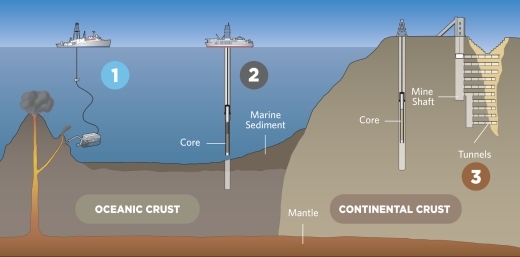
Figure 1. Illustration of the search for life in the lithosphere. At this time, life has been found at depths of nearly 4 km, but absent at 9 km where the temperatures were too high.
1. Deep-sea, manned submersibles and remotely operated vehicles collect fluid samples that exit natural points of access to the oceanic crust, such as underwater volcanoes or hydrothermal vents. These samples contain microbes living in the crust beneath.
2. Drilling holes into the Earth’s crust allows retrieval of rock and sediment cores reaching kilometers below the surface. The holes can then be filled with monitoring equipment to make long-term measurements of the deep biosphere.
3. Deep mines provide access points for researchers to journey into the Earth’s continental crust, from where they can drill even deeper into the ground or search for microbes living in water seeping directly out of the rock.
Source: [11]
From the article:
To date, studies of crustal sites all over the world—both oceanic and continental—have documented all sorts of organisms getting by in environments that, until recently, were deemed inhospitable, with some theoretical estimates now suggesting life might survive at least 10 kilometers into the crust. And the deep biosphere doesn’t just comprise bacteria and archaea, as once thought; researchers now know that the subsurface contains various fungal species, and even the occasional animal. Following the 2011 discovery of nematode worms in a South African gold mine, an intensive two-year survey turned up members of four invertebrate phyla—flatworms, rotifers, segmented worms, and arthropods—living 1.4 kilometers below the Earth’s surface.
With our existence proof of a deep, hot biosphere in Earth, is it possible that similar life could exist in the lithospheres of other rocky worlds in our solar system, including our Moon?
Mars is particularly attractive, as there is evidence Mars was both warmer and wetter in the past. There was geologic activity as clearly evident by the Tharsis bulge and the shield volcanoes like Olympus Mons. We know there is frozen water below the surface on Mars. What we are not certain of is whether Mars’ core is still molten and hot, and what the areothermal gradient is. One of the scientific goals of the Insight lander, currently on Mars, is to determine heat flow in Mars. This will help provide the data necessary to determine the range of the habitable zone in the lithosphere.
In contrast, we do have samples of Moon rock. An analysis of the Apollo 11 samples showed that organic material was present, but there was no sign of life except for terrestrial contamination [10, 12]. Since then, very little effort has been applied to look for life in the lunar rocks. The theory that the Moon is desiccated, hostile to life, and sterile, seems to have deterred further work. The early analyses indicated that methane (CH4) is present in the Apollo 11 samples. This may be primordial or delivered subsequently by impacts from asteroids or comets. If we ever discovered pockets of natural gas, even petroleum, on the Moon, this would be a staggering confirmation of Gold’s theory.
So where should we look?
Although the Moon is in our proverbial backyard, the expected depth of liquid water starts well below the bottom of the deepest craters.. This suggests that either deep boring would be necessary, or we must hope for impact ejecta to be recoverable from the needed depths. The prospects for either seem rather remote, although scientific and commercial activities on the Moon might make this possible in this century.
Despite its remoteness, Mars may be more attractive. Sampling at the bottom of crater walls and the sides of the Valles Marineris may give us relatively easy access to samples at the needed depths. Should the transient dark marks on the sides of crater walls prove to be liquid water, we would have samples within easy reach. The recent discovery of a possible subsurface water deposit just 1.5 km beneath the surface of Mars might be another possible target to reach.
The requirement that water is a necessary, but insufficient, condition for life has focused efforts on looking for life where liquid surface water exists. Because of the available techniques, exoplanet targets will be those that satisfy the HZ requirements. While these may prove the first confirmation of extraterrestrial life, they cannot answer some of the fundamental questions that we would like to know, for example, is abiogenesis common, or rare, and is panspermia the means to spread life. For that, we will need samples of such life. For the foreseeable future, that means sampling the solar system. We have 2 nearby worlds, and Gold suggested that there might be 10 suitable Moon-sized and above worlds that might have deep biospheres [5]. That might be ample.
To date, our search for life beyond Earth has been little more than looking for fish in the waves lapping the shore. We need to search more comprehensively. I am arguing that this search needs to focus on the habitable regions of lithospheres of any suitable rocky world. We might start with signs of bacterial fossils in exposed rock strata and ejecta, and then core samples taken from boreholes to look for living organisms. Finding life, especially that from a different genesis would indicate that life is indeed ubiquitous in the universe.
References
1. Barnes, J. J., Tartèse, R., Anand, M., Mccubbin, F. M., Franchi, I. A., Starkey, N. A., & Russell, S. S. (2014). The origin of water in the primitive Moon as revealed by the lunar highlands samples. Earth and Planetary Science Letters, 390, 244-252. doi:10.1016/j.epsl.2014.01.015
2. Davies, P. C., Benner, S. A., Cleland, C. E., Lineweaver, C. H., Mckay, C. P., & Wolfe-Simon, F. (2009). Signatures of a Shadow Biosphere. Astrobiology, 9(2), 241-249. doi:10.1089/ast.2008.0251
3. Davies, P. C. (2011). The eerie silence: Renewing our search for alien intelligence. Boston: Mariner Books, Houghton Mifflin Harcourt.
4. Gold, T. (1992). The deep, hot biosphere. Proceedings of the National Academy of Sciences, 89(13), 6045-6049. doi:10.1073/pnas.89.13.6045
5. Gold, T. (2010). The deep hot biosphere: The myth of fossil fuels. New York, NY: Copernicus Books.
6. Hallis, L. J., Huss, G. R., Nagashima, K., Taylor, G. J., Halldórsson, S. A., Hilton, D. R., . . . Meech, K. J. (2015). Evidence for primordial water in Earth’s deep mantle. Science, 350(6262), 795-797. doi:10.1126/science.aac4834
7. Hoffman N.(2001) Modern geothermal gradients on Mars and implications for subsurface liquids. Conference on the Geophysical Detection of Subsurface Water on Mars (2001)
8. Kuskov O (2018) Geochemical Constraints on the Cold and Hot Models of the Moon’s Interior: 1–Bulk Composition. Solar System Research, 2018, Vol. 52, No. 6, pp. 467–479.
9. Mccubbin, F. M., Steele, A., Hauri, E. H., Nekvasil, H., Yamashita, S., & Hemley, R. J. (2010). Nominally hydrous magmatism on the Moon. Proceedings of the National Academy of Sciences, 107(25), 11223-11228. doi:10.1073/pnas.1006677107
10. Nagy, B., Drew, C. M., Hamilton, P. B., Modzeleski, V. E., Murphy, S. M., Scott, W. M., . . . Young, M. (1970). Organic Compounds in Lunar Samples: Pyrolysis Products, Hydrocarbons, Amino Acids. Science, 167(3918), 770-773. doi:10.1126/science.167.3918.770
11. Offord, C. (2018) Life Thrives Within the Earth’s Crust. The Scientist, October 1, 2018.
12. Oyama, V. I., Merek, E. L., & Silverman, M. P. (1970). A Search for Viable Organisms in a Lunar Sample. Science,167(3918), 773-775. doi:10.1126/science.167.3918.773
13. Tolley, A Detecting Early Life on Exoplanets. Centauri Dreams, February 2018
14. Way, M. J., Genio, A. D., Kiang, N. Y., Sohl, L. E., Grinspoon, D. H., Aleinov, I., . . . Clune, T. (2016). Was Venus the first habitable world of our solar system? Geophysical Research Letters, 43(16), 8376-8383. doi:10.1002/2016gl069790
15. Woo, M. The Hunt for Earth’s Deep Hidden Oceans. Quanta Magazine, July 11, 2018






January 10, 2019
Technosearch: An Interactive Tool for SETI
Jill Tarter, an all but iconic figure in SETI, has just launched Technosearch, an Internet tool that includes all published SETI searches from 1960 to the present. A co-founder of the SETI Institute well known for her own research as well as her advocacy on behalf of the field, Tarter presents scientists with a way to track and update all SETI searches that have been conducted, allowing users to submit their own searches and keep the database current. The tool grows out of needs she identified in her own early research, as Tarter acknowledges:
“I started keeping this search archive when I was a graduate student. Some of the original papers were presented at conferences, or appear in obscure journals that are difficult for newcomers to the SETI field to access. I’m delighted that we now have a tool that can be used by the entire community and a methodology for keeping it current.”
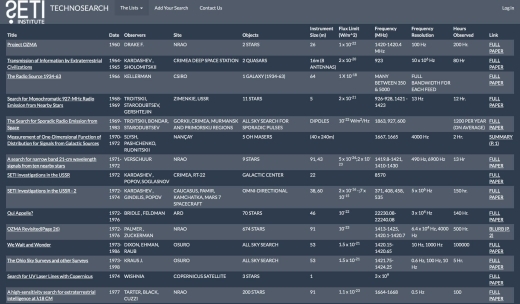
Image: Screenshot of the Radio List on https://technosearch.seti.org/.
Among the materials included in Technosearch are:
Title of the search paper
Name(s) of observers
Search date
Objects observed
Facility where the search was conducted
Size and sensitivity of the telescope used
Resolving power of the instrument
Time spent observing each object
A link to the original published research paper
Comments that explain the search strategy
Observer notes
Technosearch currently contains 102 radio searches and 38 optical searches. The tool was presented yesterday at the 2019 winter meeting of the American Astronomical Society in Seattle and will be maintained by the SETI Institute. The AAS meeting always produces interesting developments, including exoplanet investigations that I intend to discuss next week.
On Technosearch, a personal thought: No one who has not attempted a deep dive into the scholarship on SETI can know how frustrating it is to chase down lesser known investigations or details of major ones. The issue of ready availability extends to the broad field of interstellar flight research, as I learned when compiling materials for my Centauri Dreams book. The trail from conference presentation to published paper can be obscure, while materials relating to specific researchers can be scattered through library collections or spread over a range of journals, some of them with firewalls, or available only in expensive books..
I’ve long advocated for interstellar studies a return to what Robert Forward began with Eugene Mallove, a detailed bibliography whose last appearance was in the Journal of the British Interplanetary Society in 1980. Putting such a resource online opens it worldwide and strengthens a field whose online databases are in many cases incomplete and often do not include older materials. All fields of scholarship will be following this essential path even as we continue to wrestle with academic publishers over questions of access to complete texts.

Technosearch is a step forward for SETI that helps scientists work with consolidated information while building a useful archive of contemporary work going forward. Tarter developed the tool in collaboration with graduate students working with Jason Wright (Penn State), a well-known figure in Dysonian SETI, which culls astronomical data looking for the possible physical artifacts of advanced civilizations. Also in the mix is Research Experience for Undergraduates, a program supporting students in areas of research funded by the National Science Foundation.
Image: Jill Tarter and Andrew Garcia presenting the Technosearch Tool.
SETI Institute REU student Andrew Garcia worked with Tarter in the summer of 2018:
“I started helping Dr. Tarter with this project as a research opportunity during the summer. I’ve become convinced that Technosearch will become an important instrument for astronomers and amateurs interested in exploring the cosmos for indications of other technological civilizations. We can’t know where to look for evidence tomorrow if we don’t know where we have already looked. Technosearch will help us chronicle where and how we’ve looked at the sky. I would like to thank the NSF REU program and the CAMPARE program for their encouragement and support throughout this project.”






January 7, 2019
Ultrahigh Acceleration Neutral Particle Beamer: Concept, Costs and Realities
The advantages of neutral particle beam propulsion seem clear: Whereas a laser’s photon beams can exchange momentum with the sail, neutral particle beams transfer energy and are considerably more efficient. In fact, as we saw in the first part of this essay, that efficiency can approach 100 percent. A mission concept emerges, one that reaches a nearby star in a matter of decades. But what about the particle beam generators themselves, and the hard engineering issues that demand solution? For that matter, how does the concept compare with Breakthrough Starshot? Read on as James Benford, working in collaboration with Alan Mole, describes the salient issues involved in building an interstellar infrastructure.
By James Benford and Alan Mole
We discuss the concept for a 1 kg probe that can be sent to a nearby star in about seventy years using neutral beam propulsion and a magnetic sail. We describe key elements of neutral particle beam generators, their engineering issues, cost structure and practical realities. Comparison with the Starshot laser beam-driven concept gives roughly similar costs.
Beam Generator Concept

Figure 1 Block diagram of early neutral particle beam generator [1]. Drift-Tube Linac is not shown.
Creation of the neutral particle beam begins with
1. Extraction of a negative ion beam (negative ion with attached electrons) from a plasma source; it then drifts into the first acceleration stage, the RFQ. The first element of the accelerator will appear much like the geometry shown in figure 2. Here ions are extracted from the plasma source on the left by electrostatics and brought by a converging magnetic field to the linear accelerator.
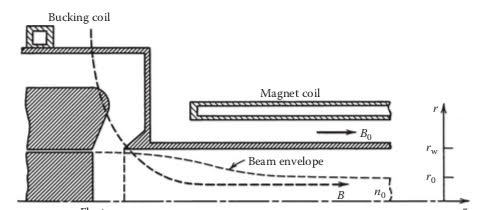
Figure 2. Ion beam on left is propagated along converging magnetic field to the linac.
2. The ion beam enters a radiofrequency quadrupole (RFQ) accelerator, a vane-like structure where the application of radiofrequency power produces a continuous gentle acceleration much like a surfer riding a wave. It also provides strong electrostatic focusing to prevent divergence growth. The structure bunches the particles in phase space.
The RFQ fulfils at the same time three different functions:
focusing of the particle beam by an electric quadrupole field, particularly valuable at low energy where space charge forces are strong and conventional magnetic quadrupoles are less effective;
adiabatic bunching of the beam: starting from the continuous beam produced by the source it creates with minimum beam loss the bunches at the basic RF frequency that are required for acceleration in the subsequent structures;
acceleration of the beam from the extraction energy of the source to the minimum required for injection into the following linac structure.
3. After the ions exit the RFQ at energies of a few MeV, further acceleration to increase the particle energy is done with a drift-tube linac (DTL), which consists of drift tubes separated by acceleration regions, as shown in Figure 3. Particles arriving at the gaps at the proper phase in the radiofrequency waves are given acceleration impulses. When the electric field of the wave reverses, the particles are shielded from being accelerated by passing through the drift tubes. The typical accelerating gradient is a few MeV/m.

Figure 3. Drift-Tube Linac, which consists of drift tubes separated by acceleration regions.
4. In order to maintain low emittance and produce the microradian divergence we desire, the beam is expanded considerably as it exits the accelerator. Beam handling elements must have minimal chromatic and spherical aberrations.
5. Beam pointing to be done by bending magnets with large apertures.
6. Finally, the extra electrons are stripped from the beam, making a neutral particle beam. This can be done with by stripping the electrons in a gas neutralization cell or by photodetachment with a laser beam. It may be possible to achieve 100% neutralization by a combination of methods. Thus far this high-efficiency neutralization has not been demonstrated.
Beamer Engineering
There are several possible schemes for building the beam generator. Both electrostatic and electromagnetic accelerators have been developed to produce high power beams. The most likely approach is to use linear accelerators. In the past, the cost of an electromagnetic accelerator is on the order of a person year per meter of accelerator (~1 man-year/m) but this could be larger for the more sophisticated technologies.
The power system to drive such accelerators could come from nuclear power (fission or fusion) or solar power. Furthermore, if it were to be space-based, the heavy mass of the TW-level high average power required would mean a substantially massive system in orbit. Therefore Mole’s suggestion, that the neutral beam be sited on Earth, has its attractions. There is also the question of the effects of propagating in the atmosphere, on both beam attenuation and on divergence.
If the beam generator were to be on Earth, it should all be at the highest altitude for practical operations. The Atacama Desert, for example, would offer very low humidity and half of sea level pressure. In addition, a way to reduce beam losses in the atmosphere would be to launch a hole-boring laser beam in advance just before the neutral beam. This laser would heat up a cylinder of atmosphere to lower the pressure, allowing the neutral beam to propagate with less loss. Such hole-boring exercises have been conducted in laser weapon studies and does appear to be a viable technique.
The final neutral beam can be generated by many small beam drivers or a single large beam driver. If a great number of driver devices and their associated power supplies are required, increasing the construction and maintenance expense of this portion. Of course, economies of scale will reduce the cost of individual segments of the Beamer by mass production of the system modules. Making such choices is an exercise for future engineers and designers.
Neutral particle beam generators so far have been operated in pulsed mode of at most a microsecond with pulse power equipment at high voltage. Going to continuous beams, which would be necessary for the seconds of beam operation that are required as a minimum for useful missions, would require rethinking the construction and operation of the generator. The average power requirement is quite high, and any adequate cost estimate would have to include substantial prime power and pulsed power (voltage multiplication) equipment, the major cost element in the system. Of course, it will vastly exceed the cost of the Magsails, which is an economic advantage of beamed propulsion.
However, this needs economic analysis to see what the cost optimum would actually be. Such analysis would take into account the economies of scale of a large system as well as the cost to launch into space versus the advantages of beaming from Earth.
Beamer Cost Estimates
The interstellar neutral particle beam system described here is a substantial extrapolation beyond the present state-of-the-art. Nevertheless, estimates can be made of both the capital and operating costs.
The cost of the Beamer is divided between the cost of the accelerator structure (RFQ and DTL) and the power system that drives it. For a cost estimate for the Mercury system, we assume that the present day accelerating gradient is maintained for this very high-power system. That gradient is ~ 2 MeV/m. For the mercury neutral particle beam the length of the 1.35 GeV accelerator would be 675 m.
There is an extensive technology base for drift-tube linacs; there are many in operation around the world [2]. We use as a model the well-documented 200 MeV Brooklyn National Laboratory 200 MeV ion beam system, which was completed in 1978 at a cost of $47M. It used 22 MW of radiofrequency power and was 145m long. In that era, the cost of microwave equipment was ~$1/W. The cost today is ~$3/W, so the 22 MW would cost 22 M$ then and 66 M$ today. Since the total cost of accelerator was $47 M$, the Accelerator structure would cost 47 M$ -22 M$ = $25 M$. Thus at this level the two cost elements are roughly equal. The accelerator structure then costs $25 M$/145 m = $0.17 M$ per meter in 1978. We multiply all costs by a factor of three to account for inflation to get today’s costs.
To estimate the capital cost of the mercury in NPB described here, we have the following relations:
Caccl= 0.5 M$/m x 675 m = 350 M$
Cmicrowave= 3$/W x 18 TW = 5.47 B$
Therefore the dominant cost element would be the microwave system driving the accelerator.
However, high-volume manufacturing will drive costs down. Such economies of scale are accounted for by the learning curve, the decrease in unit cost of hardware with increasing production. This is expressed as the cost reduction for each doubling of the number of units, the learning curve factor f. This factor typically varies with differing fractions of labor and automation, 0.7 < f < 1, the latter value being total automation.
It is well documented that microwave sources have an 85% learning curve, f = 0.85 based on large-scale production of antennas, magnetrons, klystrons, etc [3]. Today’s cost is about $3/W for ~1 MW systems. Note that this includes not only the microwave generating tube, but also the power system to drive that continuous power. The 18 TW power needed would require 18 million such units. Therefore the cost is ~1.1 B$. Adding together the accelerator and microwave power system, the cost will be 1.45 B$.
The electrical power to drive this large system cannot possibly come from the electrical grid of Earth. Therefore a large cost element will be the system that stores the 162 TJ of energy. (Note that the beam power starts at zero and rises with time (t2) to 18 TW at the end.) From Parkin’s estimates of the Starshot energy storage system [10], based on Li-ion batteries, we take the storage cost to be $50 per kilowatt-hour, which is $13,900 $/TJ. Consequently the cost for the energy store is ($13,900 $/TJ) 162 TJ = 2.25 B$. So the energy stores cost is comparable to that of the accelerator.
The total capital cost is
Caccl= 350 M$
Cmicrowave = 1.1 B$
Cstore= 2.25 B$
Total accelerator capital cost is 3.7 B$.
The operating cost to launch a single Magsail is of course far smaller. It is simply the cost of the spacecraft and the energy to launch it. We will assume that the cost of the spacecraft will be on the order of $10 million. The cost of the electricity at the current rate of $.10 per kilowatt-hour is $4.5 million.
Total operating cost for a single launch is ~15M$.
Comparison with Starshot
The neutral particle beam approach is conceptually similar to photon beams such as the laser-driven Starshot project. A disadvantage of reflecting photons from the sail will be that they carry away much of the energy because they exchange only momentum with the sail. Neutral particle beams transfer energy, which is much more efficient. The reflecting particles may in principle be left on moving in space after reflection and thus the efficient energy efficiency can approach 100%.
The Starshot system, a laser beam-driven 1 gram sail with the goal of reaching 0.2c, has been quantified in a detailed system model by Kevin Parkin [4]. Since both the high acceleration neutral particle beam described here and Starshot are both beam-driven high-velocity systems, we make the following comparison between their key parameters and cost elements:
Physical parameters and cost elements of beam-driven probes
Mercury Neutral Particle Beam SystemStarshot
Sail mass1 kg1 g
Velocity0.06 c0.2 c
Beamer capital cost1.45 B$4.9 B$
Energy store cost2.25 B$3.4 B$
Total capital cost3.7 B$8.3 B$
Energy cost/launch4.5 M$7 M$
Kinetic energy1.6 1014 J1.8 1012 J
Kinetic energy/ capital cost43.2 kJ/$0.2 kJ/$
Here we have summed the accelerator and microwave power system costs for the neutral Beamer and the laser and optics cost for Starshot. A major caveat is that Parkin’s estimates have realistic efficiencies of the systems of Starshot, but our costs assume unrealistically high efficiencies.
Although they differ in detail, the two concepts give the same order of magnitude cost. However, the kinetic energy in the NPB-driven probe is 90 times that of the Starshot probe. This shows the disadvantage of reflecting photons from the sail: they carry away much of the energy because they exchange only momentum with the sail. Neutral particle beams transfer energy, which is much more efficient. The kinetic energy/capital cost ratio is 200 times greater in the NPB case.
It is instructive that the high-energy requirement of interstellar probes drives the existence of a stand–alone storage system, which is a major element in the total cost of both systems. The similarity of costs for these rather different beam- driven systems gives us some confidence that these rough estimates in this paper are credible.
Neutral Particle Beam Realities
Practical realities are always bad news. Performance of most systems degrades to below their design points because of inefficiencies of processes. Note that the beam systems described here are perfectly efficient, as determined from equation 5. That is, the beam reflects from the sailcraft with perfect efficiency, so as to stop dead, transferring all the energy to the spacecraft. The realities of neutral particle beams in the present day are substantially poorer.
To see where the problems lie, we consider a daring experiment called BEAR, conducted 30 years ago [1, 5]. A neutral particle beam generator was actually deployed and operated in space and its performance was measured.
On July 13, 1989 the Beam Experiment Aboard Rocket (BEAR) linear accelerator was successfully launched and operated in space by Los Alamos National Laborotory. The rocket trajectory was sub-orbital, reaching altitude of 220 km. The flight demonstrated that a neutral hydrogen beam could be successfully propagated in an exoatmospheric environment. The cross-section of the rocket is shown in figure 4.
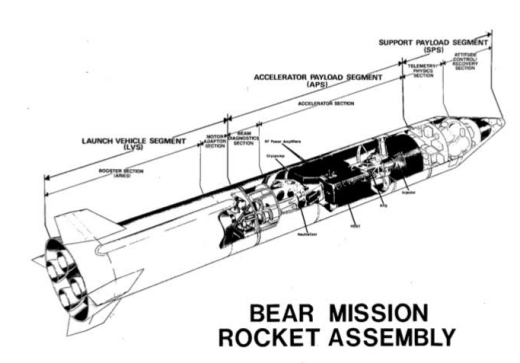
Figure 4. Beam Experiment Aboard Rocket (BEAR) [1].
The accelerator, which was the result of an extensive collaboration between Los Alamos National Laboratory and industrial partners, was designed to produce a 10 rnA, 1 MeV neutral hydrogen beam in 50 microsecond pulses at 5 Hz. The major components were a 30 kev H- injector a 1 MeV radio frequency quadrupole, two 425 MHz RF amplifiers, a gas cell neutralizer, beam optics, vacuum system and controls. The beam extracted was 1 cm in diameter with a beam divergence of 1 mradian. There was no unexpected behavior such as beam instability in space.
The design was strongly constrained by the need for a light- weight rugged system that would survive the rigors of launch and operate autonomously. The payload was parachuted back to Earth. Following the flight the accelerator was recovered and successfully operated again in the laboratory.
From the paper and report describing this experiment we see substantial inefficiencies, which should guide our future expectations.
The input power to the accelerator was 620 kW for 60 µs, a 7.2 J energy input. The beam as extracted was 27 mA at 1 MeV for 50 µs, which gives 1.35 J. The efficiency therefore is 19%, so approximately 4/5 of the energy supplied was lost in the beamline shown in figure 1. The major loss was in the neutralizer which was a xenon gas injected into the beamline. The efficiency of the neutralizer was changed by varying the amount of gas injected. They obtained 50% neutral hydrogen and 25% each of negative and positive hydrogen. Therefore the neutralization process was only 50% efficient in producing a neutral beam. This accounts for most of the loss. The other losses can be accounted for by inefficiencies in the optics of the low-energy beam region and the high-energy beam region.
In the 30 years since the flight, little work on particle beams has occurred at high power levels, because of the termination of the Strategic Defense Initiative. Doubtless substantial improvements can be made in the efficiency of NPB’s, given substantial research funding. Therefore the concept in this paper, with its hundred percent efficiency of energy transfer from the electrical system to the sail, is an upper bound on the performance. Consequently the parameters in Table 1 and the capital and operating cost estimates given here are lower bounds on what would actually occur.
Conclusions
The cost model presented here is lacking in realistic efficiencies. The next level of analysis should address this lack.
We can forsee a development path: a System starts with lower speed, lower mass Magsails for faster missions in the inner solar system. As the system grows, the neutral beam System grows and technology improves. Economies of scale lead to faster missions with larger payloads. As interplanetary commerce begins to develop, making commerce operate efficiently, outcompeting the long transit times of rockets between the planets and asteroids, the System evolves [6]. Nordley and Crowl describe such a development scenario [7]. We conclude that this concept is a promising method for interstellar travel.
References
1. P. G. Oshey, T. A. Butler, M. T. Lynch, K. F. McKenna, M. B. Pongratz, T. J. Zaugg, “A Linear Accelerator In Space-The Beam Experiment Aboard Rocket”, Proceedings of the Linear Accelerator Conference 1990.
2. H. B. Knowles, “Thirty-Five Years of Drift-Tube Linac Experience” Los Alamos Scientific Laboratory Report, LA-10138-MS, 1984. See also reference 4, pg. 81.
3. J. Benford, J. A. Swegle and E. Schamiloglu, High Power Microwaves, Third Edition, pg. 77, Taylor and Francis, Boca Raton, FL, (2015).
4. K. L. G. Parkin, “The Breakthrough Starshot System Model”, Acta Astronautica 152, 370-384, 2018.
5. G. J. Nutz, “Beam Experiments Aboard a Rocket (BEAR) Project Summary’, LA-11737, 1990.
6. J, Benford, “Beam-Driven Sails and Divergence of Neutral Particle Beams” JBIS 70, pg. 449-452, 2017.
7. G. Nordley and A. J. Crowl, “Mass Beam Propulsion, An Overview”, JBIS 68, pp. 153-166, 2015.






Paul Gilster's Blog
- Paul Gilster's profile
- 7 followers




